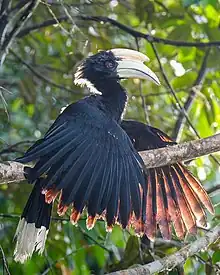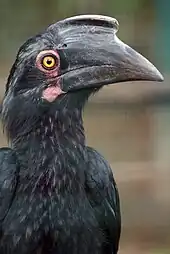| Black hornbill | |
|---|---|
 | |
| Male at London Zoo, England | |
| Scientific classification | |
| Domain: | Eukaryota |
| Kingdom: | Animalia |
| Phylum: | Chordata |
| Class: | Aves |
| Order: | Bucerotiformes |
| Family: | Bucerotidae |
| Genus: | Anthracoceros |
| Species: | A. malayanus |
| Binomial name | |
| Anthracoceros malayanus (Raffles, 1822) | |
The black hornbill (Anthracoceros malayanus) is a species of bird of the hornbill family Bucerotidae. It lives in Asia in Brunei Darussalam, Indonesia, Malaysia, Singapore, Thailand.
The Black-casqued Hornbill has a selectiveness towards the environment and resources when it comes to reproduction. It is a lowland specialist.[3] This organism will only start breeding and nesting when there is a large supply of fruits available, and in trees of larger size. When there are limited resources available, and may curtail nesting for years when there is a low availability of fruits(4). It is the major seed disperser for Durio graveolens, a species of durian.[4] The connection is strong enough to reflect in some of the common names for the fruit: The Kenyah and Dayak peoples call it durian anggang (lit. 'hornbill durian'),[5] and in Malay it is called durian burong/durian burung[6] (lit. 'durian bird').[5] It also has a role in seed disbursement for Vitex pinnata.[7]
It is known to fly for hours at a time.[3]
It is threatened by hunting and habitat loss.[3]
Diet
It is a frugivore, eating a wide range of fruits—over 50 species. It most commonly feeds on figs and Vitex pinnata;[7] its diet includes Sterculia cordata and Durio graveolens.[3]
Description
The male has a yellowish bill while the female has a dark grey bill.

References
- ↑ BirdLife International (2018). "Anthracoceros malayanus". IUCN Red List of Threatened Species. 2018: e.T22682441A132372259. doi:10.2305/IUCN.UK.2018-2.RLTS.T22682441A132372259.en. Retrieved 18 November 2021.
- ↑ "Appendices | CITES". cites.org. Retrieved 2022-01-14.
- 1 2 3 4 OKANO, TSUNEYA (1972). "A PRELIMINARY OBSERVATION OF ORANG HUTANS IN THE REHABILITATION STATION IN SEPILOK, SABAH". The Annual of Animal Psychology. 21 (2): 55–67. doi:10.2502/janip1944.21.55. ISSN 1883-6283.
- ↑ Nakashima, Yoshihiro; Lagan, Peter; Kitayama, Kanehiro (March 2008). "A Study of Fruit–Frugivore Interactions in Two Species of Durian (Durio, Bombacaceae) in Sabah, Malaysia". Biotropica. 40 (2): 255–258. doi:10.1111/j.1744-7429.2007.00335.x. ISSN 1744-7429. OCLC 5155811169. S2CID 82212472.
- 1 2 Kostermans, André Joseph Guillaume Henri (December 1958). Dilmy, A.; Van Steens, C. G. G. J. (eds.). "The Genus Durio Adans. (Bombac.)" (PDF). Reinwardtia. 4 (3): 91–95. doi:10.14203/reinwardtia.v4i3.1008 (inactive 1 August 2023). ISSN 2337-8824. OCLC 4142407. Retrieved 10 November 2017.
{{cite journal}}: CS1 maint: DOI inactive as of August 2023 (link) - ↑ O'Gara, E.; Guest, D. I.; Hassan, N. M. (2004). "Occurrence, Distribution and Utilisation of Durian Germplasm" (PDF). In Drenth, A.; Guest, D. I. (eds.). Diversity and Management of Phytophthora in Southeast Asia ACIAR Monograph No. 114. Australian Centre for International Agricultural Research (ACIAR). pp. 187–193. ISBN 978-1-86320-405-7. Archived from the original (PDF) on 19 February 2018. Retrieved 9 November 2017.
- 1 2 Perdhana, R D (2023-09-01). "The role of birds diversity in increasing oil palm productivity at PT Permata Sawit Mandiri, West Kalimantan". IOP Conference Series: Earth and Environmental Science. 1243 (1): 012011. doi:10.1088/1755-1315/1243/1/012011. ISSN 1755-1307.
- Stauffer, Donald J.; Smith, Thomas B. (2004). "Breeding and nest site characteristics of the Black-casqued Hornbill Ceratogymna atrata and White-thighed Hornbill Ceratogymna cylindricus in south-central Cameroon". Ostrich. 75 (3): 79–88. doi:10.2989/00306520409485418. S2CID 76654062.
External links
